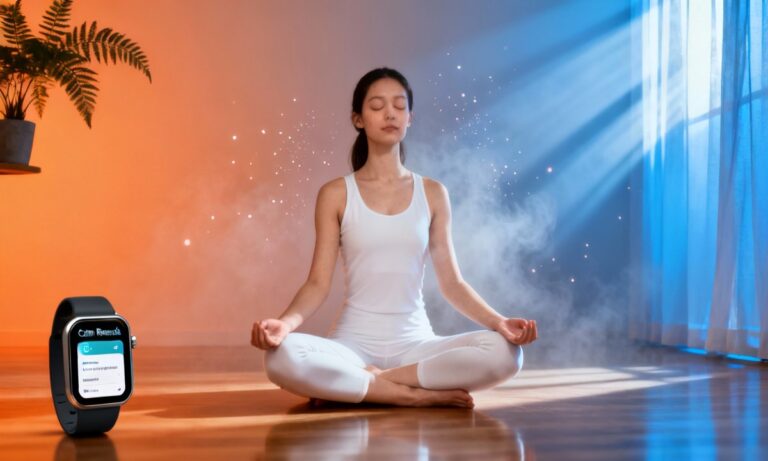Beyond basic breathwork, advanced meditation techniques offer a pathway to profound psychological transformation and self-discovery. While foundational practices introduce focus and awareness, these deeper methods unlock the mind’s capacity to cultivate resilience, compassion, and lasting inner peace. Whether you seek relief from daily stress or a profound sense of well-being, advanced meditation can guide you toward deeper calm meditation and mindful living.
Moving Beyond Basic Breathwork
Understanding the distinction between basic breathwork and advanced meditation is key. Basic breathwork provides essential groundwork, anchoring attention and regulating the nervous system. Advanced techniques, however, integrate movement, sound, and expansive states of consciousness to enhance your practice. These include body scans, visualization, and compassion-based methods, all rooted in ancient traditions and validated by modern science.
For those just starting, daily mindful breathing exercises help create the mental space needed for further exploration. As you become more comfortable with these foundational steps, you will naturally progress to methods that foster clarity, growth, and resilience. This gradual approach ensures a sustainable and enriching meditation journey.
Foundational Breathing: Preparing for Depth
Before delving into advanced practices, reinforcing a solid foundation is essential. Consistent breathwork meditation not only supports stress relief but also prepares your mind for deeper work. Techniques such as box breathing, alternate nostril breathing, and mindful observation of the breath help to calm the nervous system and enhance concentration, setting the stage for greater inner peace.
To optimize your practice environment at home, consider creating a calming, distraction-free space. Just as you might design your living area for comfort and efficiency, a dedicated meditation spot can significantly enhance your experience. Discover how to optimize your living space for comfort and savings by exploring insightful guides.
Exploring Advanced Meditation Methods
1. Mindfulness: Vipassana & Zen Approaches
Vipassana Meditation invites you to observe thoughts, emotions, and bodily sensations with radical presence and non-judgment. By simply noting feelings as they arise—such as “thinking,” “feeling,” or “sensing”—without clinging or resisting, you cultivate profound equanimity and self-awareness. This practice fosters a deeper connection to your inner landscape.
In Zen Meditation (Zazen), the practice involves simply sitting and watching thoughts pass by like clouds. This method helps you access clarity and spacious awareness, effectively dissolving mental clutter and reducing stress. It promotes a state of calm alertness, allowing you to experience the present moment more fully.
2. Concentration Techniques: Trataka & Kundalini
Trataka, or concentrated gazing, involves focusing your gaze, often on a candle flame, without blinking. This stillness trains the mind to hone in on a single point, building unwavering focus and mental discipline. It is a powerful way to enhance concentration and quiet the mind.
Kundalini Meditation, a more advanced form, seeks to awaken dormant energy through guided concentration and breathwork. This practice can yield powerful shifts in mood and consciousness. However, it often benefits significantly from expert supervision, ensuring a safe and transformative experience.
Cultivating organizational skills through meditation can mirror strategies for keeping your physical space clutter-free. Just as meditation helps clear mental space, decluttering your home can create a more serene environment. Find smart storage solutions to simplify your living.
3. Movement: Kinhin & Tai Chi Integration
Kinhin, or walking meditation, pairs slow, mindful steps with synchronistic breath. This practice roots awareness in the physical act of moving, bringing a meditative quality to everyday activities. It helps to integrate mindfulness into your physical experience.
Meanwhile, Tai Chi integrates flowing motion with meditative centeredness, building a sense of embodied mindfulness and balanced energy. This ancient art form combines gentle exercise with mental focus, promoting both physical and inner harmony. Both practices emphasize the connection between mind and body.
4. Mantra: Transcendental and Chanting Practices
Transcendental Meditation (TM) uses the silent repetition of a personal mantra. This technique aims to propel the mind beyond surface-level clutter into deeper, restorative states of consciousness. It is known for fostering profound relaxation and inner peace.
Chanting Meditation employs vocalized mantras or sacred sounds, such as “Om,” to induce meditative absorption and cultivate peace. The vibrational quality of chanting can be deeply soothing, helping to focus the mind and elevate consciousness. These practices offer unique paths to stillness.
Expert Guidance for Deeper Calm and Mindful Focus
Establishing consistency in your practice is vital. Try to schedule your meditation at the same time each day to develop a steady routine. This dedication helps to solidify your commitment and integrate meditation into your daily life, making it a natural habit.
Explore modern tech tools to enhance your meditation journey. Many meditation apps and biofeedback devices offer real-time feedback, amplifying your experience. Discover smart home gadgets for well-being that can support your mindful living practices and improve your overall environment.
Begin every session with a full-body scan to foster relaxation and presence. This simple technique helps you connect with your physical self and release any stored tension. Gradually increase the duration of your sessions, allowing your mind to adapt to deeper states of contemplation and calm.
Remember, even small shifts in your daily routine can produce significant upgrades. These improvements can positively impact your energy levels, living environment, and emotional well-being. Embrace the journey of consistent practice for lasting benefits.
Addressing Common Challenges in Advanced Practice
Restlessness is a common experience during meditation. If your mind races, gently return your focus to your breath or mantra. Recognize that distractions are natural and part of the process, and simply guide your attention back to your anchor without judgment.
Emotional release may also occur as you delve deeper into your practice. It is common for repressed feelings to surface. Allow these sensations to move through you without attachment or judgment, observing them with a sense of compassionate detachment.
Progress in meditation often fluctuates; growth is cyclical, not linear. You might experience periods of plateau. Embrace the process with patience and compassion, trusting that your practice is evolving even when it doesn’t feel like a constant upward trajectory.
Consider transforming your practice space when needed to invite fresh energy. Much like seasonal resets in your home, a refreshed meditation area can invigorate your sessions. Get deep cleaning tips here to revitalize your environment and mind.
Understanding Advanced Meditation Techniques
Advanced meditation techniques expand upon basic breathwork with structured methods. These include practices like Vipassana, Zen, Kundalini, and various visualization exercises. They aim to deepen focus, enhance self-awareness, and facilitate emotional healing. Many also incorporate mantra repetition, mindful movement, and compassion-based practices.
Achieving deeper calm through meditation emerges from sustained focus on these advanced techniques and developing a supportive, consistent routine. Mindful movement, guided visualizations, and mantra repetition all guide the mind into calm, restorative states. Consistency is key to unlocking these profound benefits.
While some advanced meditation methods, such as mindfulness and loving-kindness, can be suitable for beginners, others, like Kundalini and complex visualizations, may benefit from the guidance of an experienced teacher. Starting with foundational practices and gradually integrating advanced methods as comfort grows is often the most effective approach.
Struggling to stay focused is a natural part of meditation. Distractions are common; simply return to your anchor—your breath, gaze, or mantra—each time your mind wanders. Over time, your capacity for focus and calm will naturally increase with persistent practice.
Resources for Deeper Meditation and Mindful Living
Ready to deepen your meditation journey? Online programs, such as those for Vedic meditators, offer tailored instruction for advanced practice. These resources support the integration of calm and joy into daily life, providing structured guidance for dedicated practitioners.
Modern meditation apps and neurofeedback technologies offer guided sessions and real-time analytics. These tools make advanced practice accessible, even from the comfort of your home. They provide personalized support and insights into your meditative states.
Communities, both live and online, nurture accountability and inspiration. Seek out forums, virtual meetups, or in-person classes to share experiences and gain guidance from seasoned practitioners. Connecting with others can enrich your path.
Consider reputable external resources for the latest on meditation science. Organizations like the National Center for Complementary and Integrative Health or the UCLA Mindful Awareness Research Center offer valuable insights and research findings. These resources can deepen your understanding of meditation’s benefits.
Research and Profound Psychological Benefits
Advanced meditation is not merely about stillness; it fosters self-transcendence—a shift beyond personal concerns toward greater empathy, compassion, and connection. Research consistently highlights benefits such as enhanced mental clarity, improved mood, and long-term stress resilience, contributing to overall well-being.
Studies also point to measurable changes in brain structure and function, underscoring the transformative power of sustained practice. These physiological shifts demonstrate the profound impact meditation can have on cognitive abilities and emotional regulation, offering tangible benefits for mental health.
Moreover, advanced meditative states may assist in treating mental illness and fostering trust, purpose, and meaning in life. Emerging research suggests these techniques can even rewire underlying patterns of behavior, promoting healthier psychological responses and a more positive outlook.
Visualizing Daily Calm: A Guided Practice Example
Preparation for Visualization
Find a quiet, comfortable space where you can be undisturbed. Sit upright but relaxed, allowing your hands to rest gently on your knees. Close your eyes and take a few gentle, grounding breaths to center yourself before beginning your practice.
The Visualization Practice
Begin with a body scan: Notice your feet, legs, torso, arms, neck, and head, consciously letting any tension melt away. Next, invite mindful breathing: Inhale for four counts, hold for four, then exhale for six. Repeat this cycle five times to deepen your relaxation.
Shift to advanced visualization: Imagine a serene lake at dawn, its surface still and glassy. With each inhalation, draw in a profound sense of calm. With each exhalation, visualize releasing tension and any lingering stress, allowing it to dissipate.
Closing Your Visualization
Gradually bring your awareness back to your surroundings, taking a final deep breath before gently opening your eyes. Afterward, jot down a brief reflection about your experience. Note what changed, what challenged you, and any observations you made during the visualization.
Integrating Advanced Meditation Into Your Routine
To integrate advanced meditation into your daily life, first, select a technique that resonates with you. Choose Vipassana for awareness, Trataka for focus, or Transcendental Meditation for deep calm, depending on your personal goals and preferences.
Start small, dedicating just 10 minutes daily to your chosen practice. Gradually increase this time as you become more comfortable and adept with the technique. This gentle progression ensures that your mind and body adapt effectively.
Track your progress by noting your sessions and any shifts in clarity, emotion, or stress levels. This practice helps you observe the benefits and stay motivated. Connecting with a supportive community or online group can also provide invaluable guidance and encouragement.
Explore more on mindful living to enhance your holistic well-being, extending beyond meditation to your environment and daily habits. Discover how to transform your living space with budget-friendly ideas, create sustainable routines, and build healthy habits that reinforce your meditative journey, fostering a harmonious life.
Begin and Deepen Your Meditation Path
Advanced meditation techniques are powerful tools for transformation, guiding you beyond basic breathwork into realms of lasting calm and personal growth. By integrating these methods, cultivating a supportive environment, and engaging with a like-minded community, you unlock a pathway to resilience, clarity, and deep inner peace.
Ready to take your next step? Download our free advanced meditation checklist, or sign up for our newsletter featuring monthly guided audio sessions. You might also explore our upcoming live workshops to further your practice. Begin your journey today and experience deeper calm meditation that enriches every facet of life.



